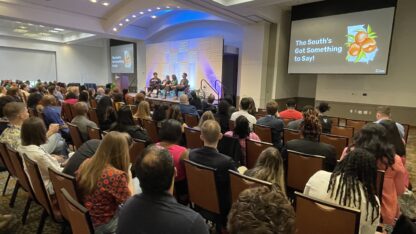High-Tech Farming: How PodPonics Grows Lettuce Indoors
This story originally aired Sept. 17, 2014.
If it weren’t for the sign just outside the entrance to the Podponics farm, you might wonder if you’d gotten the address wrong.
As you pull into the lot, the scene most resembles an industrial truck yard. Airplanes are rushing overhead, taking off from Hartsfield-Jackson, just a few miles away. And the 11 acres of land in front of you are mostly empty, with exception of a few dozen shipping containers, stacked two levels high in the middle of the lot.
It’s hard to believe that here a farm is growing row after row of lettuce, harvesting 2,000 pounds daily. Until you step inside those containers.
“We could supply all of Georgia’s lettuce needs, all of them from the land we’re on right now if we built enough containers,” said Matt Liotta, founder of PodPonics. Liotta’s company, PodPonics, is an indoor farm growing local, pesticide-free lettuce inside recycled shipping containers.
Liotta led WABE’s Stephannie Stokes on a tour of this indoor farm. Listen to that story below.
Once inside the farm, you find that it looks nothing like the inside of recycled shipping containers. It’s bright, airy and actually feels spacious. Lettuce plants are growing along multiple vertical tiers of PVC pipes lining each side of the containers.
Those pipes are a clue to how PodPonics are growing a vegetable indoors. They’re using a method called hydropnics. That means the roots of the plants are in water – not soil. The PVC pipes are distributing water to the lettuce.
The plants are also completely removed from sunlight. Instead, PodPonics has installed LED lights above each tier of lettuce and gives the plants additional nutrients as needed.
This artificial growing environment allows PodPonics to do the impossible: produce lettuce in Georgia year-round. On a traditional outdoor farm, lettuce can only be grown during the spring and fall–all other times, it’s either too hot or too cold. That’s why 99 percent of the lettuce on Atlanta’s grocery store shelves is coming from the west coast–either California or Arizona.
But what really makes Podponics special is actually the technology that they’re using to grow local lettuce indoors. Liotta is, by trade, a software developer and so when he decided he wanted to figure out a way to grow local fresh food, he turned to the tool he knew best–technology.
He and his team ended up creating software to monitor and control all aspects of the growing process.
“So there are sensors that detect the air temperature, humidity and CO2 level. Then the software automatically makes adjustments to the environment, to the irrigation, to the water chemistry, the lighting,” said Liotta, “everything that’s required to keep the lettuce growing on process.”
All of this technology helps Podponics grow lettuce in the most efficient way possible. And, in the end, it’s what makes their farm economically viable.
“So what our software does – what’s so special about it – is not just that we can modify these things, but that each one of those things that we can change, it costs money to change them. To turn on a light, it costs money. To turn on water, it costs money. To inject CO2 in the air, it costs money. All of these things cost money. Everything has a cost and our software knows what everything costs in real time.”
And it adjusts the plants’ environment based on that information. If, for example, the price of electricity falls below the price of carbon dioxide, then the software will turn up the lights. If it’s the other way around, then it will pump more carbon dioxide into the air. By constantly measuring these fluctuating costs, the software is able to create the right environment for lettuce to grow for the least amount of money.
“The ability to optimize at that level allows us to do things slightly cheaper than somebody else, which enables us to provide seemingly the impossible, which is growing in an artificial environment at a cheaper cost than growing out in the field where the sun is free and so on and so forth,” Liotta said.
And, so far, their growing method has worked pretty well. Each individual shipping container can grow four tons of greens annually. Which is a lot, if you consider that an entire acre of land can only grow 6.5 tons in a year.
It gets even more impressive when you consider, as Liotta pointed out, that you could fit about 100 of these containers, producing 400 tons of lettuce, in just one acre. And it gets crazier–these containers can be stacked, so you could just keep adding layer upon layer of containers, each producing 400 tons of lettuce.
“It does seem farfetched, very futuristic, but you’re standing here. It’s real. You can imagine this time ten,” Liotta said. “Think about the difference that would make in the local economy and the difference in food miles for lettuce.”
But of course we’re just talking lettuce. One vegetable in the produce section. While Liotta said PodPonics is starting to grow other kinds of produce, like red bell peppers and strawberries, he did emphasize that–at least, right now–PodPonics won’t be growing everything.
“Everyone asks about tomatoes,” Liotta said. “Unfortunately we have no plans for tomatoes.”
Rather, the company is best seen as just one part of a larger local food system here in Atlanta, made up of traditional, urban and now “high-tech” farmers.
9(MDAxODM0MDY4MDEyMTY4NDA3MzI3YjkzMw004))





